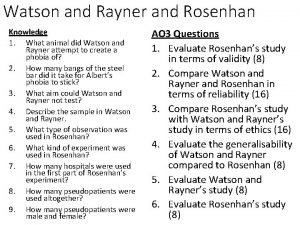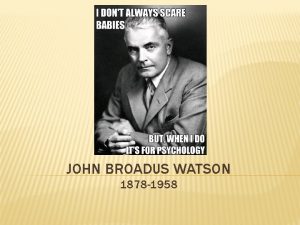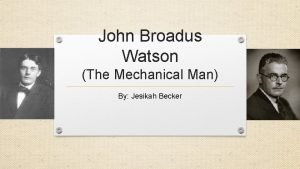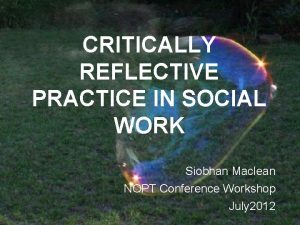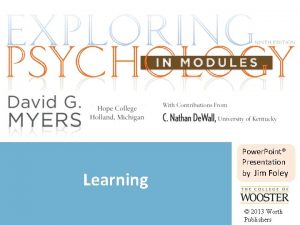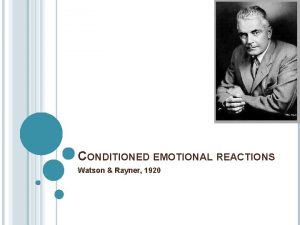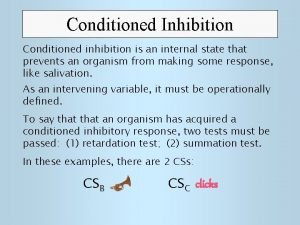CONDITIONED EMOTIONAL REACTIONS Watson Rayner 1920 AIMS 1



















- Slides: 19

CONDITIONED EMOTIONAL REACTIONS Watson & Rayner, 1920

AIMS 1. To investigate whether it is possible to condition a fear of an animal in a baby 2. To see whether that fear would be transferred to other animals and objects ?

AIMS 3. To investigate the effect of time on such conditioned emotional responses 4. If the responses do not extinguish themselves, then to investigate what laboratory methods can be devised for their removal ?

PARTICIPANT Little Albert aged 9 months - 1 year 21 days Mother a wet nurse at the Harriet Lane Home for Invalid Children This was where Albert had been raised Albert ‘normal’ Stolid and unemotional

“No one had ever seen him in a state of fear or rage. ” “The infant practically never cried. ”

“We felt we could do him relatively little harm by carrying out experiments such as those outlined below. . . ”

PROCEDURE Method Single case study conducted under laboratory conditions Using observational techniques to record data

PROCEDURE Approx 9 months Little Albert was shown a series of stimuli � White rat � Rabbit Neutral stimuli � Dog � Monkey � Masks � Cotton wool � Burning newspapers At NO time did Little Albert show any fear

PROCEDURE Unconditioned stimulus 8 months & 26 days 1. A steel bar was struck with a sharp blow behind Albert’s head Albert showed ‘startled reaction’ 2. 3. The steel bar was struck again Albert again showed a ‘startled reaction & his lips puckered and trembled The steel bar was struck for the third time Unconditioned Albert started crying response

PROCEDURE Establishment of conditioned emotional responses 11 months and three days A white rat was taken from a basket and presented to Albert Just as he reached for the rat the steel bar was struck behind his head Little Albert showed a fear reaction by jumping violently and falling forward

PROCEDURE 11 months 10 days 1. The rat was presented without the steel bar and Albert was hesitant to touch the animal This shows the procedure that was performed the previous week had some effect. . . Then the experimental procedure began again. . . 2. The rat and steel bar were presented together Little Albert ‘started’ and fell over

PROCEDURE 3. Joint stimulation again. Albert fell over again and turn away from the rat 4. Joint stimulation – same reaction 5. Rat presented alone – Albert whimpers and withdraws his body 6. Joint stimulation. Albert fell over again and started to whimper 7. Joint stimulation. Albert started violently and cried!

PROCEDURE Conditioned stimulus Conditioned emotional response 8. Rat presented alone – Albert cries and crawls away so quickly that he almost falls off the table

It takes seven joint stimulation trials in all to make Little Albert cry and establish the fear response!

PROCEDURE TESTING AIM 2 – WILL ALBERT'S FEAR RESPONSE GENERALISE TO OTHER OBJECTS? 11 months 15 days 1. Albert is shown the rat again and shows a fear response 2. Albert is then shown a rabbit. He show a fear response by whimpering then bursting into tears and buried his head in the mattress then crawled off crying

PROCEDURE Little Albert shows a similar fear response to: Fur coat Cotton wool Santa mask A dog

PROCEDURE TESTING AIM 3 – THE EFFECT OF TIME ON CONDITIONED EMOTIONAL RESPONSES No further conditioning experimentation was conducted on Little Albert for 31 days One Year 21 days Little Albert was presented with � The Santa mask � The Fur Coat � The Rat � The Dog He showed a fear response to all of them

“These experiments seem to show conclusively that directly conditioned emotional responses as well as those conditioned by transfer, persist”

“Our view is that these responses in the home environment are likely to persist indefinitely”
 Watson and rayner
Watson and rayner Little albert
Little albert John broadus watson emma watson
John broadus watson emma watson Experimento de watson
Experimento de watson John b. watson emma watson
John b. watson emma watson James broadus watson
James broadus watson Unit 5 chemical reactions answers
Unit 5 chemical reactions answers An example of redox reaction
An example of redox reaction Chemical reactions section 2 classifying chemical reactions
Chemical reactions section 2 classifying chemical reactions Types of reactions
Types of reactions Section 2 reinforcement classifying chemical reactions
Section 2 reinforcement classifying chemical reactions Malthusin ansa
Malthusin ansa The weather model of reflection
The weather model of reflection Anjula gupta
Anjula gupta Donna rayner
Donna rayner George francis rayner ellis
George francis rayner ellis Badminton conditioned games
Badminton conditioned games Difference between conditioned and unconditioned reflex
Difference between conditioned and unconditioned reflex Neutral stimulus becomes a conditioned stimulus
Neutral stimulus becomes a conditioned stimulus The inventory of good learner repertoires
The inventory of good learner repertoires
